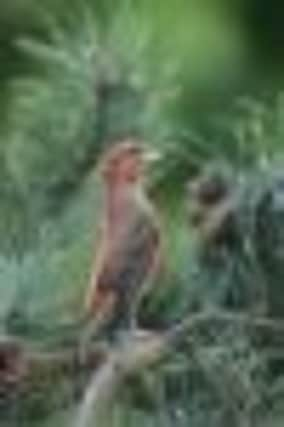Outdoors: The three crossbills


But the silence is deceptive and it is not unusual when walking through these woods for the still air to be suddenly broken by a distant and rather metallic repetitive “chip, chip” call. This gets gradually louder and over the trees appears a small party of crossbills that quickly settle on a Scots pine. But crossbills are restless birds and soon take to the air again, their calls gradually fading into the distance.
For the dedicated twitcher, such a brief encounter can be a rather frustrating experience, for the crossbills seen here can belong to any one of three species that are so similar it takes a real expert to tell them apart. Indeed, such are the similarities between the common crossbill, the parrot crossbill and the Scottish crossbill that there is still some debate as to their true classification.
Advertisement
Hide AdAdvertisement
Hide AdBut what is indisputable is that our crossbills are rather handsome birds, especially the males with their vibrant brick-red plumage and deep bills that have led to them being likened to parrots. They are also one of our most specialist feeders, with their unique crossed-over bills specially designed to extract the seeds from conifer cones.
It is only in recent times that it has come to light that Scotland hosts three distinct types of crossbill. Ron Summers of the RSPB has studied crossbills in Scotland intensively and he is in little doubt that the variations in each type of crossbill and their selection of mates of the same type are enough to classify them as different species. From a conservation point of view this is an incredibly important discovery, given that it means the Scottish crossbill is Scotland’s only endemic bird.
Ron says: “The slightly different calls of the three species probably reinforces mate selection and keeps hybridisation between the various types to a very low level. I’ve calculated that the cross-mating in crossbill types is only about four per cent, which is at a similar level to Darwin’s Galapagos finches, which are recognised as distinct species.”
The differences between the three are subtle – the common crossbill generally having a slightly smaller bill in comparison to the others, the parrot crossbill the largest bill, and the Scottish crossbill somewhere in between. However, they also have slightly different calls and exhibit behavioural differences too. The common crossbill often travels across large distances and generally appears in Scotland in intermittent influxes from Europe in search of new feeding areas when the cone crop on the continent has failed. Good numbers will then stay here to breed but it is thought that many eventually drift back to Europe. The parrot crossbill is a specialist of Scots pine and also exhibits some nomadic tendencies, although not nearly to the same degree as the common crossbill, whereas the Scottish crossbill is more sedentary and only undertakes relatively small-scale movements within Scotland.
The three species have also evolved different breeding and feeding strategies. The parrot crossbill lays its eggs in February and March so as to time the fledging of the young when the cones of Scots pines start to open, thus making it easier for the youngsters to feed upon them. The Scottish crossbill tends to start breeding in March and the common crossbill in April in Scots pine woods, although the latter can breed at other times of the year because of its ability to exploit a variety of other conifers that produce seed at different times.
While the Scottish crossbill, like the parrot crossbill, seems to prefer Scots pine, in recent decades it has begun to take advantage of maturing plantations of non-native species such as lodgepole pine. Here the cones are smaller and the seed easier to extract than those of Scots pine and there is the intriguing possibility that Scottish crossbills may even start to evolve slightly smaller bills as a result.
We still know comparatively little about our three species of crossbills, how they interact and if there are any long-term population trends. Changes in forestry practices – such as a move away from lodgepole pine to other tree types because of the disease known as red band needle blight – could impact upon crossbill numbers in the future. But the little light that has been shed so far has revealed a bird with the most fascinating taxonomic and behavioural traits.